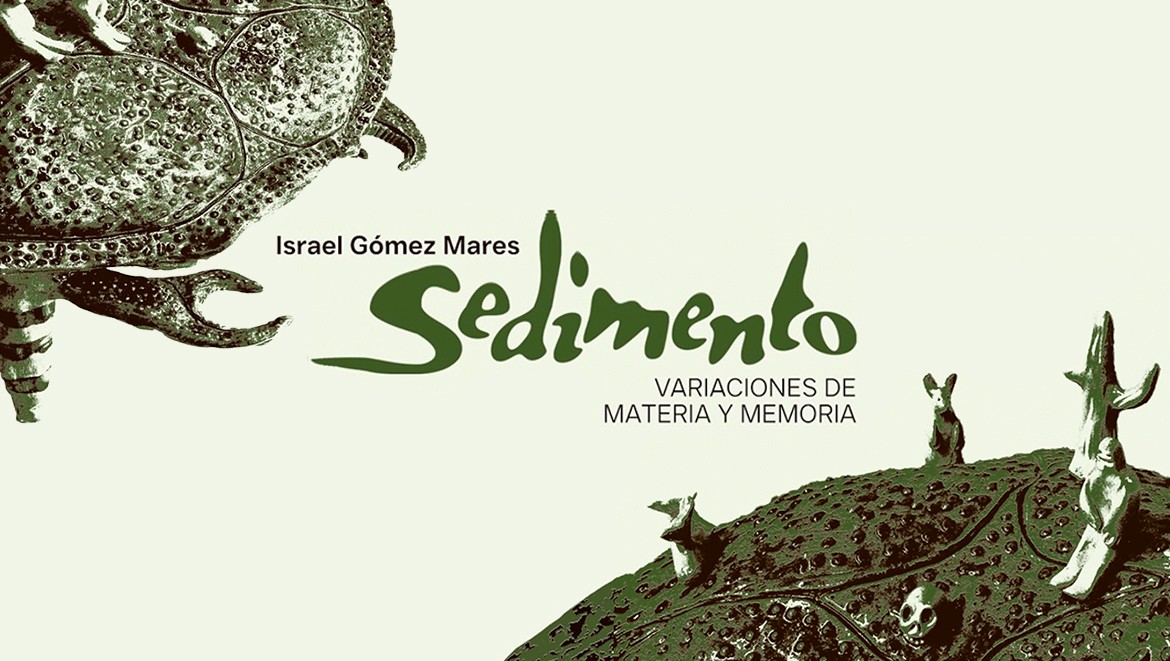Sedimento es una exploración de cómo la memoria, la materia y la identidad se acumulan y transforman con el tiempo, tal como lo hacen los sedimentos en la tierra. A través de esculturas y objetos cargados de significado, Israel Gómez Mares invita a una experiencia física y emocional con los materiales que habitan su paisaje. La exposición plantea una conexión íntima entre cuerpo, territorio y recuerdo, revelando cómo incluso un grano de arena puede contener historias profundas. Lo material deja de ser solo materia: se vuelve huella, eco y mapa de lo que somos.
Fecha:
Diciembre 2024 - 15 de marzo, 2025
Curaduría:
Jess Tolbert

TEXTO CURATORIAL
Estás parado en la orilla de un río, o tal vez sentado en la cima de una duna... El limo y la arena bajo tus pies, habiendo llegado desde otro lugar, ahora están aquí, conectándote con este momento.
Así como los sedimentos geológicos se acumulan gradualmente, preservando los residuos de eventos, materiales y experiencias pasadas, Sedimento explora el proceso por el cual el significado, la memoria y la materia se asientan, transforman y perduran. La obra de Israel Gómez Mares aborda el sedimento tanto como una presencia física como metafórica, reflejando su continua exploración de cómo las capas de identidad, paisaje y memoria se acumulan y se moldean entre sí con el tiempo. Entre estas capas de significado, Gómez Mares construye un mundo que nos atrae hacia una experiencia directa y encarnada con su obra.
¿Sentiste eso?
Involucrarse con Sedimento implica volverse profundamente consciente de la relación del cuerpo con lo material: ya sea el propio al interactuar con la obra, el del artista en el proceso de creación, o los cuerpos de arcilla estirados, tallados y moldeados en figuras, recipientes e historias. Esta corporeidad es también un eco de la experiencia personal de Gómez Mares dentro del paisaje desértico y urbano, no solo como fuente de inspiración, sino como origen de materiales. Capas recolectadas e impregnadas de arena o de óxido, por ejemplo, nos invitan a reflexionar sobre el significado de los materiales que a menudo pasamos por alto y que se acumulan con el tiempo.
Entonces, ¿qué puede contarnos un grano de arena?
Los objetos actúan como marcadores tangibles de la experiencia, donde lo material y la memoria se vuelven inseparables. Al igual que un recuerdo físico, un objeto puede detener en el tiempo un momento, ofreciendo un referente más estable que la propia memoria, la cual, como el sedimento, está en constante cambio y movimiento. Esto nos dice que estos materiales no son meramente funcionales; llevan consigo el peso del pasado y el presente de la región, ofreciendo una conexión conmovedora entre la experiencia personal del artista y el paisaje cultural en general.
Sedimento entreteje estas nociones en un mapa imaginario, donde las formas escultóricas actúan como puntos cardinales a lo largo de tu viaje. Este paisaje y sus habitantes son a la vez elementales y míticos; sus posturas y formas son contradictorias, evocando tanto familiaridad como misterio, vulnerabilidad y poder. Nos desafían a reconsiderar nuestra relación con los ecosistemas que habitamos.
Creo que ya hemos estado aquí antes.
En esta exposición, el sedimento se convierte en algo más que un residuo; es un registro, un espejo y una huella viva. Sus contornos revelan las complejidades de la identidad, la memoria y el lugar, moldeando y transformando silenciosamente lo que nos define.
- Jess Tolbert
You are standing on the bank of a river, or maybe sitting atop a dune... The silt and sand beneath your feet,
having arrived from someplace else, are now here grounding you in this moment.
Just as geological sediments build up gradually, preserving the residues of past events, materials, and experiences, Sedimento explores the process by which meaning, memory, and matter settle, transform, and endure. The work of Israel Gómez Mares engages with sediment as both a physical and metaphorical presence, reflecting his continued exploration of how layers of identity, landscape, and memory accumulate and shape one another over time. Between these layers of meaning, Gómez Mares builds a world that draws us in, to a direct and embodied experience with his work.
Did you feel that?
To engage with Sedimento is to become acutely aware of the body's relationship to material—whether your own through interaction with the artwork, the artist’s in the process of making, or the bodies of clay stretched, carved, and shaped into figures, vessels, and stories. This corporeality is also an echo of Gómez Mares’ personal experience within the desert and urban landscape, not only as a site of inspiration, but in the sourcing of material. Collected and infused layers of sand or rust, for example, invite us to consider the meaning of material often overlooked and accumulated over time.
So, what can a grain of sand tell us?
Objects act as tangible markers of experience, where material and memory become inseparable. Like a souvenir, a physical object can hold a moment in time, offering a more stable reference than memory itself, which, like sediment, is constantly shifting and changing. This tells us that these materials are not merely functional; they carry with them the weight of the region’s past and present, offering a poignant connection between the artist’s personal experience and the broader cultural landscape.
Sedimento weaves these notions together on an imagined map, with the sculptural forms acting as cardinal points along your journey. This landscape and its inhabitants are at once elemental and mythic, their postures and forms contradictory—evoking both familiarity and mystery, vulnerability and power. They challenge us to reconsider our relationship to the ecosystems we inhabit.
I think we’ve been here before.
In this exhibition, sediment becomes more than just a residue; it is a record, a mirror, and a living trace. The contours of which reveal the complexities of identity, memory, and place, quietly shaping and transforming what defines us.
-Jess Tolbert
OPENING
Fotografía:
montaje
Fotografía: